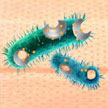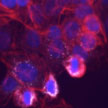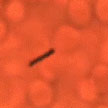Showing Spotlights 241 - 248 of 556 in category All (newest first):
 A growing body of medical nanotechnology research deals with the development of antibacterial applications, ranging from nanotechnology-based approaches for diagnosing superbugs to antimicrobial surface coatings and wound treatment with antibacterial nanomaterials. Especially silver nanomaterials have been used effectively against different bacteria, fungi and viruses but also carbon nanomaterials like nanotubes and graphene. In new work, researchers have now designed an antibacterial system combining graphene quantum dots with a low dose of a common medical reagent, hydrogen peroxide H2O2.
A growing body of medical nanotechnology research deals with the development of antibacterial applications, ranging from nanotechnology-based approaches for diagnosing superbugs to antimicrobial surface coatings and wound treatment with antibacterial nanomaterials. Especially silver nanomaterials have been used effectively against different bacteria, fungi and viruses but also carbon nanomaterials like nanotubes and graphene. In new work, researchers have now designed an antibacterial system combining graphene quantum dots with a low dose of a common medical reagent, hydrogen peroxide H2O2.
Jun 12th, 2014
 Numerous nanotoxicological studies reporting effects of nanomaterials typically address a single exposure at high dosages that are irrelevant to realistic human exposure. Recognizing that acute in vitro work had extremely low correlation to in vivo nanomaterial studies, coupled with the recognition that the unique characteristics that distinguish nanomaterials vary as a function of time, researchers sought to identify a model that would allow for the evaluation of nanomaterial behavior over a 3-month period, but be carried out in an in vitro model.
Numerous nanotoxicological studies reporting effects of nanomaterials typically address a single exposure at high dosages that are irrelevant to realistic human exposure. Recognizing that acute in vitro work had extremely low correlation to in vivo nanomaterial studies, coupled with the recognition that the unique characteristics that distinguish nanomaterials vary as a function of time, researchers sought to identify a model that would allow for the evaluation of nanomaterial behavior over a 3-month period, but be carried out in an in vitro model.
Jun 4th, 2014
 The formation of protein corona is a continuous state of flux in which many proteins compete to bind to the nanoparticle surface, each with their own characteristics such as concentration, structure and solubility determining their final affinity to the nanoparticle surface. This is the reason why biological responses to nanoparticles are strongly dependent to the type and amount of associated proteins in the composition of the protein corona. The protein corona determines the biological fate of nanoparticles and physiological responses. New research findings now show that the plasma protein alterations associated with different diseases, medical conditions, or even lifestyle, can affect the protein composition and content of the hard corona composition.
The formation of protein corona is a continuous state of flux in which many proteins compete to bind to the nanoparticle surface, each with their own characteristics such as concentration, structure and solubility determining their final affinity to the nanoparticle surface. This is the reason why biological responses to nanoparticles are strongly dependent to the type and amount of associated proteins in the composition of the protein corona. The protein corona determines the biological fate of nanoparticles and physiological responses. New research findings now show that the plasma protein alterations associated with different diseases, medical conditions, or even lifestyle, can affect the protein composition and content of the hard corona composition.
Jun 3rd, 2014
 Nanobioreactors are emerging as advanced bio-devices, which fuse the advantages of nanomaterials with those of nanobiotechnology. Due to their ultimately small size, high surface area and simulation capacity, they are set to become to be a versatile tool to fabricate ultra-sensitive and selective novel nanobio-devices, which offer us new platform to tackle key energy, medical and environmental issues. Now, a novel two-dimensional bioreactor offers a simple and effective way to overcome many limitations that have been faced by previous designs.
Nanobioreactors are emerging as advanced bio-devices, which fuse the advantages of nanomaterials with those of nanobiotechnology. Due to their ultimately small size, high surface area and simulation capacity, they are set to become to be a versatile tool to fabricate ultra-sensitive and selective novel nanobio-devices, which offer us new platform to tackle key energy, medical and environmental issues. Now, a novel two-dimensional bioreactor offers a simple and effective way to overcome many limitations that have been faced by previous designs.
May 21st, 2014
 For years, scientists and engineers have worked to design electronics which can interface with the body. However, typical silicon wafer-based electronics, which are planar and stiff, are not suited to interface with the soft, curvilinear, and dynamic environment that biology presents. By exploiting the features of shape-memory polymer (SMP) substrates, an international team of researchers has now demonstrated a unique form of adaptive electronics which softly conform or deploy into 3D shapes after exposure to a stimulus. The resulting organic thin-film transistors (OTFTs) can change their mechanical properties from rigid and planar, to soft and compliant, in order to enable soft and conformal wrapping around 3D objects, including biological tissue.
For years, scientists and engineers have worked to design electronics which can interface with the body. However, typical silicon wafer-based electronics, which are planar and stiff, are not suited to interface with the soft, curvilinear, and dynamic environment that biology presents. By exploiting the features of shape-memory polymer (SMP) substrates, an international team of researchers has now demonstrated a unique form of adaptive electronics which softly conform or deploy into 3D shapes after exposure to a stimulus. The resulting organic thin-film transistors (OTFTs) can change their mechanical properties from rigid and planar, to soft and compliant, in order to enable soft and conformal wrapping around 3D objects, including biological tissue.
May 7th, 2014
 Prevention and treatment of neurological disorders in humans necessitate delivery of therapeutic or neuroprotective agents across the so-called blood-brain barrier (BBB) into the brain. The scarcity of techniques for brain-specific delivery of therapeutic molecules using non-invasive approaches has led researchers to increasingly explore the promising potential of nanotechnology toward the diagnosis and treatment of diseases/disorders incurable with present techniques. A recent example of these efforts is the research to analyze the intra- and intercellular transport and fate of novel nanoparticles for drug delivery to the central nervous system.
Prevention and treatment of neurological disorders in humans necessitate delivery of therapeutic or neuroprotective agents across the so-called blood-brain barrier (BBB) into the brain. The scarcity of techniques for brain-specific delivery of therapeutic molecules using non-invasive approaches has led researchers to increasingly explore the promising potential of nanotechnology toward the diagnosis and treatment of diseases/disorders incurable with present techniques. A recent example of these efforts is the research to analyze the intra- and intercellular transport and fate of novel nanoparticles for drug delivery to the central nervous system.
May 1st, 2014
 While nanotechnology researchers have made great progress over the past few years in developing self-propelled nano objects, these tiny devices still fall far short of what their natural counterparts' performance. Today, artificial nanomotors lack the sophisticated functionality of biomotors and are limited to a very narrow range of environments and fuels. In another step towards realizing the vision of tiny vessels roaming around in human blood vessels working as surgical nanorobots, researchers have now demonstrated, for the first time, externally driven nanomotors that move in undiluted human blood.
While nanotechnology researchers have made great progress over the past few years in developing self-propelled nano objects, these tiny devices still fall far short of what their natural counterparts' performance. Today, artificial nanomotors lack the sophisticated functionality of biomotors and are limited to a very narrow range of environments and fuels. In another step towards realizing the vision of tiny vessels roaming around in human blood vessels working as surgical nanorobots, researchers have now demonstrated, for the first time, externally driven nanomotors that move in undiluted human blood.
Apr 17th, 2014
 Nanocellulose from wood is a promising nanomaterial with potential applications as a substrate for printing electronics, filtration, or biomedicine. Researchers have now reported on a method to control the surface chemistry of nanocellulose. They fabricated nanocellulose gels that have a significantly higher swelling degree in neutral and alkaline conditions, compared to an acid environment. This material could be of great interest for critical wound healing applications.
Nanocellulose from wood is a promising nanomaterial with potential applications as a substrate for printing electronics, filtration, or biomedicine. Researchers have now reported on a method to control the surface chemistry of nanocellulose. They fabricated nanocellulose gels that have a significantly higher swelling degree in neutral and alkaline conditions, compared to an acid environment. This material could be of great interest for critical wound healing applications.
Apr 10th, 2014
 A growing body of medical nanotechnology research deals with the development of antibacterial applications, ranging from nanotechnology-based approaches for diagnosing superbugs to antimicrobial surface coatings and wound treatment with antibacterial nanomaterials. Especially silver nanomaterials have been used effectively against different bacteria, fungi and viruses but also carbon nanomaterials like nanotubes and graphene. In new work, researchers have now designed an antibacterial system combining graphene quantum dots with a low dose of a common medical reagent, hydrogen peroxide H2O2.
A growing body of medical nanotechnology research deals with the development of antibacterial applications, ranging from nanotechnology-based approaches for diagnosing superbugs to antimicrobial surface coatings and wound treatment with antibacterial nanomaterials. Especially silver nanomaterials have been used effectively against different bacteria, fungi and viruses but also carbon nanomaterials like nanotubes and graphene. In new work, researchers have now designed an antibacterial system combining graphene quantum dots with a low dose of a common medical reagent, hydrogen peroxide H2O2.
 Subscribe to our Nanotechnology Spotlight feed
Subscribe to our Nanotechnology Spotlight feed





